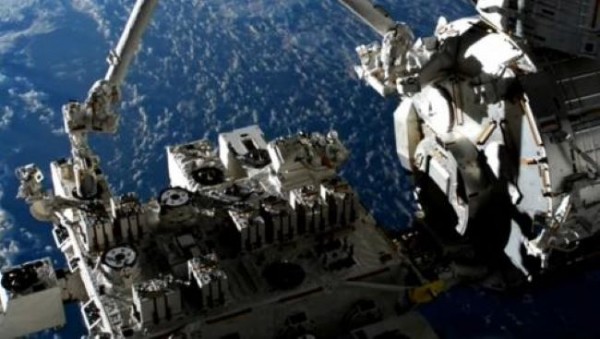UMD-led Satellite Instrument Going on a Brief Sabbatical
Instead of its intended, permanent end, the Global Ecosystem Dynamics Investigation (GEDI) will take a well-deserved break from collecting data critical for Earth science, ecology and climate change
As University of Maryland (UMD) students ready themselves for a summer break, a UMD-led satellite instrument has already started to enjoy the same.
The Global Ecosystem Dynamics Investigation (GEDI) is an instrument that produces highly accurate measures of forest height, structure, and surface elevation through a laser measurement method called lidar. Recently, GEDI was moved off the International Space Station (ISS) spot that it has spent the last four years on (EFU-6), to another location on the ISS (EFU-7) where it will remain in hibernation for roughly two years.
Originally planned as a two-year mission, GEDI was extended to early 2023, at which point it was scheduled to be released into space to drift down and ultimately burn up in the atmosphere.
“Last summer we really started worrying about this, because GEDI is collecting unique data and was showing no signs of degradation. So we started a dialogue with NASA to explore options to keep the mission operational,” said Professor Ralph Dubayah of the Department of Geographical Sciences (GEOG), GEDI’s Principal Investigator.
In the hopes of gathering evidence of the positive impact GEDI has had on Earth science, ecology and climate change, the GEDI team put out a call—primarily via GEDI’s Twitter page, @GEDI_Knights—for researchers to share how they have used GEDI data. The team received many enthusiastic responses, as well as a general outpouring of support from commercial companies, entities like the U.S. Forest Service and European Space Agency, and leaders like Senator Chris Van Hollen, Senator Ben Cardin, and Congressman Steny H. Hoyer (all D-Md.), the three of whom wrote a letter to the National Aeronautics and Space Administration (NASA) urging it to extend GEDI’s mission.
At the same, Dubayah said, NASA officials were working with the ISS to understand how GEDI and the agency’s other Earth science instruments on the platform could extend their missions.
“It was a very gratifying experience; it was wonderful to get that kind of support because it provided a broad scientific consensus,” Dubayah recalled. “It added to what we already knew about the importance of the mission and amplified it.”
In December 2022, Dubayah and collaborators from NASA’s Goddard Space Flight Center presented to NASA headquarters a summary of the accomplishments of the GEDI mission, as well as what could additionally be gained by GEDI with an extension. Shortly thereafter, the team received word that while the mission would still need to press pause so a Department of Defense technology demonstration mission could be completed, but GEDI would not be terminated.
“Demand is high for external attachment points on the station, and GEDI is scheduled to be temporarily replaced by a Department of Defense payload after more than four years of operations. However, the agency is planning to keep the instrument in space and reinstall it to continue through the life of the space station,” NASA said in a statement.
The ISS is scheduled to de-orbit in the year 2030. This could mean that GEDI would have a presence on the ISS from 2024-2030, which would allow GEDI to capture—from the start of its original mission to 2030— roughly ten years’ worth of data.
“Having a full decade of GEDI data will allow us to move from mapping current forest carbon stocks to changes in carbon between 2020-2030; essential information to understand the role of forests in the climate change story,” said Laura Duncanson, GEOG Assistant Professor. “We are going to be pouring over this data and making discoveries for years to come!”
Keeping ISS space constraints in mind and remaining appreciative of the NASA support that has enabled GEDI to be such an impactful mission, Dubayah is cautiously optimistic about GEDI’s future.
“GEDI has had a tremendously successful four years in orbit, and we're very proud of the revolutionary data that GEDI has produced,” he said. “Because the instrument is still working so well and we are in the middle of a climate crisis, we're very interested to see if there are ways of keeping the mission going, and the plan that exists now provides a pathway for GEDI to start collecting a new era of observations. Yes, there is still an element of uncertainty about it, but we remain quite hopeful that NASA’s efforts to continue the mission will be successful.”
The photo of GEDI in its new home on the ISS is from a GEOG UMD YouTube video documenting its transition from EFU-6 to EFU-7 on 17 March 2023.
This article was first published by BSOS.
Published on Thu, 05/18/2023 - 12:49


